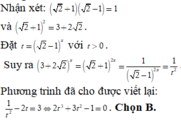Cho phương trình . Khi đặt , phương trình đã cho trở thành phương trình nào trong các phương trình dưới đây
Hãy nhập câu hỏi của bạn vào đây, nếu là tài khoản VIP, bạn sẽ được ưu tiên trả lời.


Ta có:
2(a − 1)x − a(x − 1) = 2a + 3
⇔(a − 2)x = a + 3 (3)
Do đó, khi a = 2, phương trình (2) tương đương với phương trình 0x = 5.
Phương trình này vô nghiệm nên phương trình (2) vô nghiệm.

a: \(\left\{{}\begin{matrix}\dfrac{12}{x-3}-\dfrac{5}{y+2}=63\\\dfrac{8}{x-3}+\dfrac{15}{y+2}=-13\end{matrix}\right.\)
\(\Leftrightarrow\left\{{}\begin{matrix}\dfrac{24}{x-3}-\dfrac{10}{y+2}=126\\\dfrac{24}{x-3}+\dfrac{45}{y+2}=-39\end{matrix}\right.\Leftrightarrow\left\{{}\begin{matrix}\dfrac{-55}{y+2}=165\\\dfrac{12}{x-3}-\dfrac{5}{y+2}=63\end{matrix}\right.\)
\(\Leftrightarrow\left\{{}\begin{matrix}y+2=\dfrac{-1}{3}\\\dfrac{12}{x-3}=48\end{matrix}\right.\Leftrightarrow\left\{{}\begin{matrix}y=-\dfrac{7}{3}\\x=\dfrac{13}{4}\end{matrix}\right.\)

1/a/\(\Leftrightarrow\left(x+5\right)\left(x+6\right)=0\)
\(\Leftrightarrow\orbr{\begin{cases}x+5=0\\x+6=0\end{cases}\Leftrightarrow\orbr{\begin{cases}x=-5\\x=-6\end{cases}}}\)
Vậy ...................
b/ ĐKXĐ:\(x\ne2;x\ne5\)
.....\(\Rightarrow3x^2-15x-x^2+2x+3x=0\)
\(\Leftrightarrow2x^2-10x=0\)
\(\Leftrightarrow2x\left(x-5\right)=0\)
\(\Leftrightarrow\hept{\begin{cases}2x=0\\x-5=0\end{cases}\Leftrightarrow\orbr{\begin{cases}x=0\left(nhận\right)\\x=5\left(loại\right)\end{cases}}}\)
Vậy ..............
`Answer:`
`1.`
a. \(\left(x+5\right)\left(2x+1\right)-x^2+25=0\)
\(\Leftrightarrow\left(x+5\right)\left(2x+1\right)-\left(x^2-25\right)=0\)
\(\Leftrightarrow\left(x+5\right)\left(2x+1\right)-\left(x+5\right)\left(x-5\right)=0\)
\(\Leftrightarrow\left(x+5\right)\left(2x+1-x+5\right)=0\)
\(\Leftrightarrow\left(x+5\right)\left(x+6\right)=0\)
\(\Leftrightarrow\orbr{\begin{cases}x+5=0\\x+6=0\end{cases}\Leftrightarrow\orbr{\begin{cases}x=-6\\x=-5\end{cases}}}\)
b. \(\frac{3x}{x-2}-\frac{x}{x-5}+\frac{3x}{\left(x-2\right)\left(x-5\right)}=0\left(ĐKXĐ:x\ne2;x\ne5\right)\)
\(\Leftrightarrow\frac{3x\left(x-5\right)}{\left(x-2\right)\left(x-5\right)}-\frac{x\left(x-2\right)}{\left(x-2\right)\left(x-5\right)}+\frac{3x}{\left(x-2\right)\left(x-5\right)}=0\)
\(\Leftrightarrow\frac{3x\left(x-5\right)-x\left(x-2\right)+3x}{\left(x-2\right)\left(x-5\right)}=0\)
\(\Leftrightarrow3x\left(x-5\right)-x\left(x-2\right)+3x=0\)
\(\Leftrightarrow3x^2-15x-x^2+2x+3x=0\)
\(\Leftrightarrow2x\left(x-5\right)=0\)
\(\Leftrightarrow\orbr{\begin{cases}2x=0\\x-5=0\end{cases}\Leftrightarrow\orbr{\begin{cases}x=0\\x=5\text{(Không thoả mãn)}\end{cases}}}\)
`2.`
\(ĐKXĐ:x\ne-m-2;x\ne m-2\)
Ta có: \(\frac{x+1}{x+2+m}=\frac{x+1}{x+2-m}\left(1\right)\)
a. Khi `m=-3` phương trình `(1)` sẽ trở thành: \(\frac{x+1}{x-1}=\frac{x+1}{x+5}\left(x\ne1;x\ne-5\right)\)
\(\Leftrightarrow\orbr{\begin{cases}x+1=0\\\frac{1}{x-1}=\frac{1}{x+5}\end{cases}\Leftrightarrow\orbr{\begin{cases}x+1=0\\x-1=x+5\end{cases}}\Leftrightarrow\orbr{\begin{cases}x=-1\\-1=5\text{(Vô nghiệm)}\end{cases}}}\)
b. Để phương trình `(1)` nhận `x=3` làm nghiệm thì
\(\Leftrightarrow\hept{\begin{cases}\frac{3+1}{3+2-m}=\frac{3+1}{3+2-m}\\3\ne-m-2\\3\ne m-2\end{cases}}\Leftrightarrow\hept{\begin{cases}\frac{4}{5+m}=\frac{4}{5-m}\\m\ne\pm5\end{cases}}\Leftrightarrow\hept{\begin{cases}5+m=5-m\\m\ne\pm5\end{cases}}\Leftrightarrow m=0\)

\(2x^3+7x^2+7x+2=0\)
\(\Leftrightarrow\left(2x^3+4x^2\right)+\left(3x^2+6x\right)+\left(x+2\right)=0\)
\(\Leftrightarrow2x^2\left(x+2\right)+3x\left(x+2\right)+\left(x+2\right)=0\)
\(\Leftrightarrow\left(x+2\right)\left(2x^2+3x+1\right)=0\)
\(\Leftrightarrow\left(x+2\right)\left[2x\left(x+1\right)+\left(x+1\right)\right]=0\)
\(\Leftrightarrow\left(x+2\right)\left(x+1\right)\left(2x+1\right)=0\)
.......................................................................................
\(x^3-8x^2-8x+1=0\)
\(\Leftrightarrow\left(x+1\right)\left(x^2-x+1\right)-8x\left(x+1\right)=0\)
......................................................................................

\(a,ĐK:x,y\ne2\)
Đặt \(\left\{{}\begin{matrix}x-2=a\\y-2=b\end{matrix}\right.\)
\(HPT\Leftrightarrow\left\{{}\begin{matrix}\dfrac{2}{a}+\dfrac{3}{b}=5\\\dfrac{3}{a}+\dfrac{2}{b}=5\end{matrix}\right.\Leftrightarrow\left\{{}\begin{matrix}\dfrac{6}{a}+\dfrac{9}{b}=15\\\dfrac{6}{a}+\dfrac{4}{b}=10\end{matrix}\right.\Leftrightarrow\left\{{}\begin{matrix}\dfrac{2}{a}+\dfrac{3}{b}=5\\\dfrac{5}{b}=5\end{matrix}\right.\\ \Leftrightarrow\left\{{}\begin{matrix}\dfrac{2}{a}+3=5\\b=1\end{matrix}\right.\Leftrightarrow\left\{{}\begin{matrix}a=1\\b=1\end{matrix}\right.\Leftrightarrow x=y=3\left(tm\right)\)
\(b,ĐK:x\ge3;y\ge1\)
Sửa: \(\sqrt{x-3}-\sqrt{y-1}=4\)
Đặt \(\left\{{}\begin{matrix}a=\sqrt{x-3}\ge0\\b=\sqrt{y-1}\ge0\end{matrix}\right.\)
\(HPT\Leftrightarrow\left\{{}\begin{matrix}a-2b=2\\a-b=4\end{matrix}\right.\Leftrightarrow\left\{{}\begin{matrix}a-b=4\\-b=-2\end{matrix}\right.\Leftrightarrow\left\{{}\begin{matrix}a=6\\b=2\end{matrix}\right.\\ \Leftrightarrow\left\{{}\begin{matrix}x-3=36\\y-1=4\end{matrix}\right.\Leftrightarrow\left\{{}\begin{matrix}x=39\\y=5\end{matrix}\right.\)

Thay m=-5 vào (1), ta được:
\(x^2-2x-5-3=0\)
\(\Leftrightarrow x^2-2x-8=0\)
\(\Leftrightarrow x^2-4x+2x-8=0\)
\(\Leftrightarrow\left(x-4\right)\left(x+2\right)=0\)
\(\Leftrightarrow\left[{}\begin{matrix}x=4\\x=-2\end{matrix}\right.\)

Bài làm :
a) Thay m=-5 vào PT ; ta được :
\(x^2-2x-8=0\)
\(\Delta'=\left(-1\right)^2-1.\left(-8\right)=9>0\)
=> PT có 2 nghiệm phân biệt :
\(\hept{\begin{cases}x_1=\frac{1+\sqrt{9}}{1}=4\\x_2=\frac{1-\sqrt{9}}{1}=-2\end{cases}}\)
b) Đk để PT có 2 nghiệm phân biệt :
\(\Delta'>0\Leftrightarrow\left(-1\right)^2-1.\left(m-3\right)=1-m+3=4-m>0\)
\(\Rightarrow m< 4\)
Khi đó ; theo hệ thức Vi-ét ; ta có :
\(\hept{\begin{cases}x_1+x_2=2\left(1\right)\\x_1x_2=m-3\end{cases}}\)
Mà :
\(x_1=3x_2\Rightarrow x_1-3x_2=0\left(2\right)\)
Từ (1) và (2) ; ta có HPT :
\(\hept{\begin{cases}x_1+x_2=2\\x_1-3x_2=0\end{cases}}\Rightarrow\hept{\begin{cases}x_1=\frac{3}{2}\\x_2=\frac{1}{2}\end{cases}}\)
\(\Rightarrow x_1x_2=\frac{3}{4}\Rightarrow m=\frac{3}{4}+3=\frac{15}{4}\left(TMĐK\right)\)
Vậy m=15/4 thì ...
a,x\(^2\)-2x+m-3=0 (*)
thay m=-5 vào pt (*) ta đk:
x\(^2\)-2x+(-5)-3=0⇔x\(^2\)-2x-8=0
Δ=(-2)\(^2\)-4.1.(-8)=36>0
⇒pt có hai nghiệm pb
\(x_1=\dfrac{2+\sqrt{36}}{2}=4\) , \(x_2=\dfrac{2-\sqrt{36}}{2}=-2\)
vậy pt đã cho có tập nghiệm S=\(\left\{4;-2\right\}\)
b,\(x^2-2x+m-3=0\) (*)
Δ=(-2)\(^2\)-4.1.(m-3)=4-4m+12=16-4m
⇒pt luôn có hai nghiệm pb⇔Δ>0⇔16-4m>0⇔16>4m⇔m<4
với m<4 thì pt (*) luôn có hai nghiệm pb \(x_1,x_2\)
theo hệ thức Vi-ét ta có:
\(\left\{{}\begin{matrix}x_1+x_2=2\\x_1.x_2=m-3\end{matrix}\right.\) (1) ,(2)
\(x_1,x_2\) TM \(x_1=3x_2\) (3)
từ (1) và (3) ta đk:
\(\left\{{}\begin{matrix}x_1+x_2=2\\x_1=3x_2\end{matrix}\right.\Leftrightarrow\left\{{}\begin{matrix}3x_2+x_2=2\\x_1=3x_2\end{matrix}\right.\Leftrightarrow\left\{{}\begin{matrix}4x_2=2\\x_1=3x_2\end{matrix}\right.\Leftrightarrow\left\{{}\begin{matrix}x_2=\dfrac{1}{2}\\x_1=3x_2\end{matrix}\right.\Leftrightarrow\left\{{}\begin{matrix}x_2=\dfrac{1}{2}\\x_1=\dfrac{3}{2}\end{matrix}\right.\)
thay \(x_1=\dfrac{3}{2},x_2=\dfrac{1}{2}\) vào (2) ta đk:
\(\dfrac{3}{2}.\dfrac{1}{2}=m-3\Leftrightarrow3=4m-12\Leftrightarrow4m=15\Leftrightarrow m=\dfrac{15}{4}\) (TM)
vậy m=\(\dfrac{15}{4}\) thì pt (*) có hai nghiệm pb \(x_1,x_2\) TMĐK \(x_1=3x_2\)

\(\Leftrightarrow2m.2^x+\left(2m+1\right)\left(3-\sqrt{5}\right)^x+\left(3+\sqrt{5}\right)^x=0\)
\(\Leftrightarrow\left(\frac{3+\sqrt{5}}{2}\right)^x+\left(2m+1\right)\left(\frac{3-\sqrt{5}}{2}\right)^x+2m< 0\)
Đặt \(t=\left(\frac{3+\sqrt{5}}{2}\right)^x,0< t\le1\Rightarrow\frac{1}{t}=\left(\frac{3-\sqrt{5}}{2}\right)^x\)
Phương trình trở thành :
\(t+\left(2m+1\right)\frac{1}{t}+2m=0\) (*)
a. Khi \(m=-\frac{1}{2}\) ta có \(t=1\) suy ra \(\left(\frac{3+\sqrt{5}}{2}\right)^x=1\Leftrightarrow x=0\)
Vậy phương trình có nghiệm là \(x=0\)
b. Phương trình (*) \(\Leftrightarrow t^2+1=-2m\left(t+1\right)\Leftrightarrow\frac{t^2+1}{t+1}=-2m\)
Xét hàm số \(f\left(t\right)=\frac{t^2+1}{t+1};t\in\)(0;1]
Ta có : \(f'\left(t\right)=\frac{t^2+2t+1}{\left(t+1\right)^2}\Rightarrow f'\left(t\right)=0\Leftrightarrow=-1+\sqrt{2}\)
t f'(t) f(t) 0 1 0 - + 1 1 -1 + căn 2 2 căn 2 - 2
Suy ra phương trình đã cho có nghiệm đúng
\(\Leftrightarrow2\sqrt{2}-2\le-2m\le1\Leftrightarrow\sqrt{2}-1\ge m\ge-\frac{1}{2}\)
Vậy \(m\in\left[-\frac{1}{2};\sqrt{2}-1\right]\) là giá trị cần tìm

Chọn B.